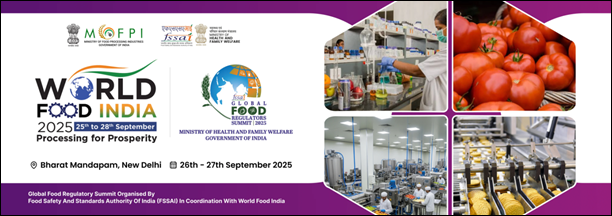The Ministry of Food Processing Industries (MoFPI) launched World Food India (WFI) in 2017 as its flagship international platform to promote India’s food sector and attract global investment. After successful editions in 2023 and 2024, the fourth edition is set to take place from September 25 to 28, at Bharat Mandapam, New Delhi. A curtain-raiser for the event was held on July 23 in the national capital. Prime Minister Narendra Modi today is scheduled to inaugurate the event.
World Food India’s idea was simple yet ambitious: to showcase India’s rich food culture, highlight its enormous agricultural strength, and bring global investors to the country’s food processing landscape. After its debut in 2017, the event returned with even greater momentum in 2023 and 2024, creating a reputation as a premier global platform for collaboration. Now, in 2025, the fourth edition is set to be the largest so far, marking a crucial step in positioning India as a global food hub.
Over 90 countries will participate in this event, with more than 2,000 exhibitors spread across Bharat Mandapam. Partner countries this year include New Zealand and Saudi Arabia, while Japan, the UAE, Vietnam, and Russia are participating as focus countries. This international presence underscores the recognition that India’s food sector is no longer just about feeding its own billion-plus population; it is about contributing to global food security, innovation, and trade.
The journey from where India was a decade ago to where it stands now tells its own story. In 2014–15, processed food accounted for just 13.7% of India’s agricultural exports. By 2024–25, that figure had jumped to 20.4%, with overall agricultural and processed food exports touching USD 49.4 billion. This growth has been fueled by consistent policy support, better infrastructure, and rising global demand. Over the past decade, India also received USD 7.33 billion in FDI equity inflows into the food processing sector, a sign of the confidence global investors have in India’s potential.
The government has played an active role in pushing this transformation. From creating 24 mega food parks and 22 agro-processing clusters to completing 289 cold chain projects and 305 processing and preservation units, the focus has been on building modern infrastructure that reduces wastage and adds value. Initiatives like Operation Greens, 225 R&D projects, and new patents have brought innovation into the sector. Meanwhile, schemes like the Pradhan Mantri Kisan Sampada Yojana and the PM Formalisation of Micro Food Processing Enterprises have ensured that even small and micro units are not left behind. Employment numbers also reflect this expansion, with more than 2.23 million workers engaged in registered units and 4.68 million in the unregistered sector.
Alongside these schemes, the Production Linked Incentive Scheme for Food Processing Industry (PLISFPI), with an outlay of ₹10,900 crore, is building global champions by boosting Indian brands in international markets. A separate Production Linked Incentive Scheme for Millet-Based Products is also promoting ready-to-eat and ready-to-cook millet foods, pushing India’s traditional grains into the global superfood category. Combined with 100% FDI in food processing and dedicated credit support through NABARD, the ecosystem for growth has been firmly established.
Against this backdrop, World Food India 2025 becomes not just another exhibition but a stage where India’s progress is put before the world. High-level panel discussions, sectoral exhibitions, business-to-business and government-to-business meetings, and chef competitions will showcase both the industrial and cultural sides of India’s food sector. Two major international events will also take place alongside: the 3rd Global Food Regulators Summit by FSSAI, where global regulators will discuss harmonization of food safety standards, and the 24th India International Seafood Show, which highlights India’s growing seafood export potential.
If one looks at the past editions, especially the 2024 edition, the momentum becomes clearer. In 2024, held at the same venue, the event saw 1,557 exhibitors, 20 country pavilions, and nearly 2,400 foreign delegates. Japan was the partner country that year, and Iran and Vietnam participated as focus countries. Importantly, 67 food processing units were inaugurated, with an investment of over ₹5,000 crore, and support worth more than ₹2,300 crore was provided to micro projects under the PMFME scheme. The event demonstrated how India is no longer just hosting discussions but is delivering tangible results.
World Food India 2025 will now take that vision forward, aligning itself with the larger dream of Viksit Bharat 2047, where India aims to become a developed and globally competitive nation. By focusing on sustainability, infrastructure, entrepreneurship, global leadership, and innovation, the event is directly linked to improving farmer incomes, boosting rural prosperity, reducing post-harvest losses, and creating jobs in smaller cities and towns. Climate-smart technologies, nutrition-focused products, and advanced food tech will be at the center of discussions, reflecting both the challenges and opportunities of the future.
The benefits of such a platform extend far beyond the four days of exhibition. For farmers, it means better markets, reduced wastage, and higher incomes as food processing units expand across the country. For entrepreneurs and start-ups, it opens doors to funding, mentorship, and global collaborations. For consumers, it translates into greater availability of nutritious, safe, and innovative food products. And for the global community, it means India is stepping up as a trusted partner at a time when food security, sustainability, and supply chain stability are urgent global priorities.














